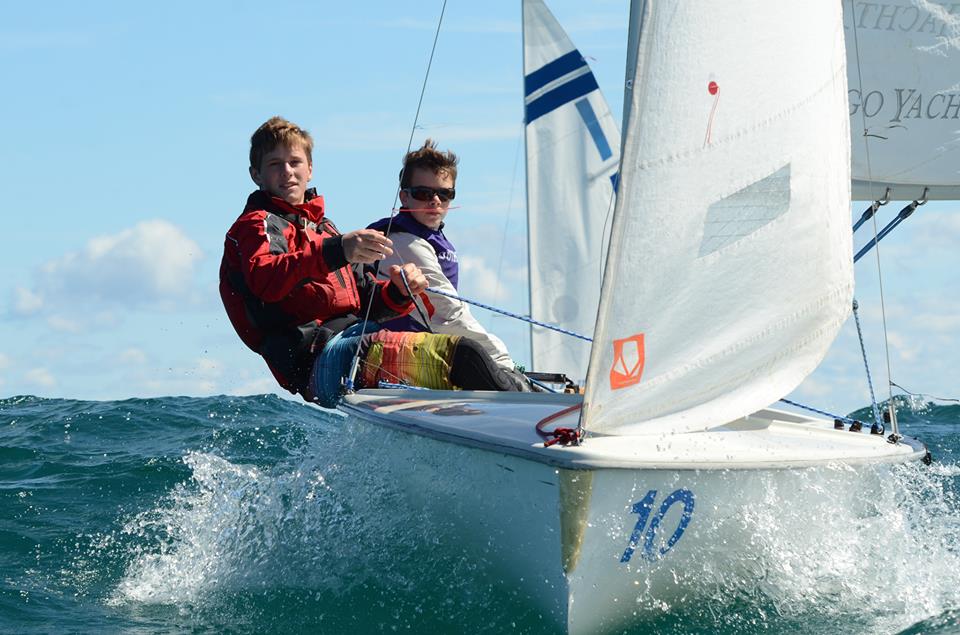How do raceS work?
Sailboat racing takes many forms. There are countless types of sailboats and nearly unlimited environments in which to sail. Although all the variables can seem daunting, when it comes down to it sailboat racing is an engaging, dynamic, and thrilling sport! Luckily, weekly racing at MSC is limited to only a couple of different types of racing, which we describe below.
What are Regattas?
In simple terms, a regatta is a series of sailboat races. At MSC, we have High School sailing regattas in the spring and fall and one or two regattas in the summer for youth and adults. We also have a weekly race series on Wednesday evenings. Regattas and weekly races are a great way for new and experienced sailors to challenge themselves and improve!
what are the rules?
Sailboat racing is governed by the Racing Rules of Sailing as adopted by US Sailing.
For new sailors, the key sections of the rules to understand are the Definitions Section, and Sections 1 (Fundamental Rules) and 2 (When Boats Meet).
Here are two videos explaining some basic rules: Sail vs. Sail and The Race Course
BOAT DESIGN
Most races at MSC utilize one-design sailboats. Similar to NASCAR racing, one-design racing means every single sailboat in the race is exactly the same. Different types of sailboats have Classes with certain specifications that boatmakers must follow to ensure all boats are the same.
At MSC we sail C Scows, Ensigns, 420s, and Lasers. Ensigns are a great boat for learning to race because an experienced skipper can bring a few new racers as crew. C Scows are sailed by two or three people and they are built for speed with a large mainsail and flat bottom. 420s have two sails and are doublehanded boats meaning they are sailed by two people; a skipper who steers the boat and trims the mainsail, and a crew who sits in front and trims the jib sail. Lasers are singlehanded boats sailed by a single skipper.
race course
There are two main types of race courses in sailboat racing:
Short Course or Buoy Racing - Sailboats start at the same time and sail around a course (usually marked by buoys) a predetermined number of times. Boats are then scored by the position in which they finish. Weekly races at MSC usually last around 30 minutes.
Two common buoy racing courses are the Windward/leeward and Digital N. The windward/leeward course is often used in fleet racing and involves sailing directly towards the wind (windward) and then sailing with the wind at your back (leeward) and repeating. The Digital N course is sailed in the shape of the letter "N" and is often used for team racing.
Distance or Offshore Racing - Sailboats race over long distances and use landmarks, buoys, or other objects to mark the course. Races can last hours, days, or even weeks. The Vendée Globe is an example of distance racing. Unfortunately, Bde Maka Ska is too small to do any distance races.
Judges sight down the starting line and call out boats that cross early
STARTING LINE
Both buoy and distance racing use a starting line to begin the race. A starting line is an imaginary line between a Pin (buoy) and the judge's boat. A series of flags and horns are used to signal a timed starting sequence. For races at MSC, the sequence is usually three minutes long.
Boats sail back and forth behind the starting line during the sequence. At the end of three minutes, the sailboats are free to cross the line and begin the race. If a sailboat crosses the start line early they are forced to take a penalty, which involves sailing back and recrossing the start line. If a sailboat does not properly take a penalty they are considered OCS (On Course Side) and is disqualified from the race.
Similar to the starting line, there is a finish line that sailboats cross to end the race. The start line often serves as the finish line as well.
Race formats
Fleet Racing - 3 or more sailboats racing against each other. Sailboats are scored based on their finishing position (1 point for 1st place, 2 for 2nd place, 3 for 3rd, etc.). The sailboat with the lowest score after a series of races is the winner.
Team Racing - Two teams of 3 sailboats compete head-to-head. The winner of each race is the team with the fewest total points. For example, a team that finishes in 1st, 3rd, and 6th place has a total of 10 points, while the other team finishes 2nd, 4th, and 5th for a total of 11 points. The finishing positions are referred to as “combinations.” Any combination of points that adds up to 10 or less is a “winning combination.”
Team race regattas are generally a round-robin format. If there are 10 teams in the regatta, each team will race against the other team. The team with the best overall win/loss record, in the end, wins the regatta.
Match Racing - Two sailboats race head-to-head. Match racing regattas can be a series of head-to-head races, a round-robin, or tournament bracket style. The America’s Cup is a Match Racing regatta.
SCHEDULE
The Racing season starts in late May and runs through mid-September. Click here to view the schedule. Plan to arrive at least 30 minutes before the start of the race to get rigged and ready. The basic schedule for sailboat races is as follows.
Wednesday Nights - Please register for Wednesday night races by clicking here
Racers should arrive by 5:30 pm to check in and rig their boats.
C Scow races start at 6:00 pm followed by the Ensigns, then Lasers and 420s together.
We aim to sail two races on Wednesday nights.







